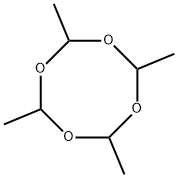Metaldehyde
- CAS NO.:9002-91-9
- Empirical Formula: CH2O
- Molecular Weight: 30.03
- MDL number: MFCD00134115
- EINECS: 618-341-4
- SAFETY DATA SHEET (SDS)
- Update Date: 2024-12-18 13:37:16

What is Metaldehyde?
Chemical properties
White crystalline powder
The Uses of Metaldehyde
META(R) Metaldehyde is a highly effective active ingredient to control slugs and snails (molluscicide) WWW Link
The Uses of Metaldehyde
In compressed form as a fuel instead of alcohol; molluscicide.
Definition
A polymer of acetaldehyde in which n usually is 4–6.
Definition
A solid compound,C4O4H4(CH3)4, formed by polymerizationof ethanal (acetaldehyde) in diluteacid solutions below 0°C. Thecompound, a tetramer of ethanal, isused in slug pellets and as a fuel forportable stoves.
Hazard
Flammable, dangerous fire risk. Strong irritant to skin and mucous membranes.
Carcinogenicity
There is no evidence in the literature that metaldehyde has carcinogenic potential.
Environmental Fate
Plant. When applied to citrus rinds, 50% was lost after 4.6 days for the first 33 days and an additional 25% was lost 14 days for the subsequent 26 days (Iwata et al., 1982). Chemical/Physical. Metaldehyde can be converted to acetaldehyde by heating to 150°C for 4–5 hours or by the reaction of concentrated hydrochloric acid (6 M) for a couple of minutes (Booze and Oehme, 1985).
Properties of Metaldehyde
| Melting point: | 190-196 °C (subl.)(lit.) |
| Boiling point: | 267.82°C (rough estimate) |
| Density | 0,808 g/cm3 |
| refractive index | 1.4455 (estimate) |
| Flash point: | 50 °C |
| storage temp. | 0-6°C
|
| solubility | Chloroform (Slightly, Heated), Methanol (Very Slightly) |
| form | powder |
| Water Solubility | 0.2g/L(17 ºC) |
| Merck | 14,5923 |
| CAS DataBase Reference | 9002-91-9(CAS DataBase Reference) |
| EPA Substance Registry System | Acetaldehyde, homopolymer (9002-91-9) |
Safety information for Metaldehyde
| Signal word | Danger |
| Pictogram(s) |
 Flame Flammables GHS02  Skull and Crossbones Acute Toxicity GHS06 |
| GHS Hazard Statements |
H228:Flammable solids H301:Acute toxicity,oral H330:Acute toxicity,inhalation |
| Precautionary Statement Codes |
P210:Keep away from heat/sparks/open flames/hot surfaces. — No smoking. P240:Ground/bond container and receiving equipment. P241:Use explosion-proof electrical/ventilating/lighting/…/equipment. P260:Do not breathe dust/fume/gas/mist/vapours/spray. P264:Wash hands thoroughly after handling. P264:Wash skin thouroughly after handling. |
Computed Descriptors for Metaldehyde
New Products
Tert-butyl bis(2-chloroethyl)carbamate 4-Methylphenylacetic acid N-Boc-D-alaninol N-BOC-D/L-ALANINOL 3-Morpholino-1-(4-nitrophenyl)-5,6-dihydropyridin- 2(1H)-one Furan-2,5-Dicarboxylic Acid Tropic acid DIETHYL AMINOMALONATE HYDROCHLORIDE 1,1’-CARBONYLDIIMIDAZOLE R-2-BENZYLOXY PROPIONIC ACID 1,1’-CARBONYLDI (1,2-4 TRIAZOLE) N-METHYL INDAZOLE-3-CARBOXYLIC ACID (2-Hydroxyphenyl)acetonitrile 4-Bromopyrazole 5-BROMO-2CYANO PYRIDINE 5,6-Dimethoxyindanone 5-broMo-2-chloro-N-cyclopentylpyriMidin-4-aMine 2-(Cyanocyclohexyl)acetic acid 4-methoxy-3,5-dinitropyridine 2-aminopropyl benzoate hydrochloride 1-(4-(aminomethyl)benzyl)urea hydrochloride diethyl 2-(2-((tertbutoxycarbonyl)amino) ethyl)malonate tert-butyl 4- (ureidomethyl)benzylcarbamate Ethyl-2-chloro((4-methoxyphenyl)hydrazono)acetateRelated products of tetrahydrofuran








You may like
-
 Metaldehyde CAS 9002-91-9View Details
Metaldehyde CAS 9002-91-9View Details
9002-91-9 -
 Metaldehyde CAS 9002-91-9View Details
Metaldehyde CAS 9002-91-9View Details
9002-91-9 -
 1975-50-4 98%View Details
1975-50-4 98%View Details
1975-50-4 -
 2-HYDROXY BENZYL ALCOHOL 98%View Details
2-HYDROXY BENZYL ALCOHOL 98%View Details
90-01-7 -
 2-Chloro-1,3-Bis(Dimethylamino)Trimethinium Hexafluorophosphate 221615-75-4 98%View Details
2-Chloro-1,3-Bis(Dimethylamino)Trimethinium Hexafluorophosphate 221615-75-4 98%View Details
221615-75-4 -
 14714-50-2 (2-Hydroxyphenyl)acetonitrile 98+View Details
14714-50-2 (2-Hydroxyphenyl)acetonitrile 98+View Details
14714-50-2 -
 118753-70-1 98+View Details
118753-70-1 98+View Details
118753-70-1 -
 733039-20-8 5-broMo-2-chloro-N-cyclopentylpyriMidin-4-aMine 98+View Details
733039-20-8 5-broMo-2-chloro-N-cyclopentylpyriMidin-4-aMine 98+View Details
733039-20-8